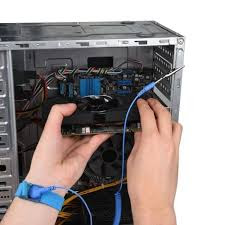Assembling a PC (Part-2)
In last post i have discussed 4 main points about assembling a PC,
They are as follows:-
- Preparing the cabinet.
- Installing the SMPS.
- Installing the motherboard back plate.
- Connecting a case fan to the cabinet.
In this post, i will discuss next steps which will be even more helpful for assembling a PC.
The topics which we are going to discuss are:-
- Installing the CPU or Processor.
- Installing heat sink on Processor.
- Installing RAM on Motherboard.
- Placing motherboard inside the cabinet.
Installing the CPU or processor.
After completing the 4 steps from last post, Now it is time to install the CPU (Central Processing Unit) or the processor on the motherboard.
But wait, before installing the Processor take all the necessary precautions to avoid static electricity problem.
What is static electricity?
For eg:- If you walk on a carpet and then grab a metal doorknob. You might get a quick shock. This is Static Electricity.
An anti-static wrist band is used to safely ground a person working on electronic equipment such as computers, to prevent build-up of static electricity in the body.
So, wear an anti-static wrist band when assembling or disassembling a PC.
Tip:-
Before starting with the installation, make sure that the motherboard and processor are compatible with each other.
Wanna know how to check the compatibility between the two?
Check the compatibility list on the website of the manufacturer showing motherboard types, the processors supported and the corresponding RAM and HDD supported.
To determine if the processor is supported, check the website of your motherboard manufacturer. Manufacturers maintain a CPU supported list. The CPU support list will specify which processor model numbers are supported.
Here are the tips to install the Processor on the motherboard.
The first step would be to place the motherboard on an anti-static flat surface.
Release the small metal lever holding the CPU retention bracket to CPU socket in the motherboard and remove the plastic cover placed on the socket pins.
Hold the processor from its corners, avoiding touching the contact points of the processor on the socket.
Make sure that you align the guiding notches on the socket with the notches along the edges of your chip.
These notches are designed to prevent you from placing the CPU in the socket in an improper manner.
Once you have installed the processor in the socket, lower the retention bracket back into its place. Make sure that you slip the notch at the end of the bracket around the single screw at the base of the socket.
Next, use the metal lever to lock the CPU into its place.
Take care that you dont break the lever while lowering it down.
Installing Heat Sink on processor.
Once the processor has been installed, the next step would be to install the heat sink on the processor.
Tip:-
Check if the heat sink already has a thermal compound coating before starting with the installation steps.
Here are the installation steps.
Apply a small amount of thermal paste, enough to cover the metal surface of heat sink. Too much thermal paste can hinder performance and too less will not serve the purpose.
Hold the heat sink level parallel to the CPU surface to ensure that the thermal paste spreads evenly in all directions.
Secure it to the motherboard with the help of plastic push-pins.
Inspect the heat sink to confirm that it is sitting flush on the CPU.
Give the fasteners a gentle upward tug to be certain that they are locked into place.
Make sure that all fasteners are locked.
Installing RAM on the motherboard.
Once the heat sink has installed, the next step would be to install RAM on the motherboard.
Here are the tips to install the RAM.
Locate the memory slots on your desktop using the owners manual.
Align the notches on the module with the ridges in the memory slot.
Insert the RAM module using firm hands and even pressure and push down the module until the clips on the side of the slot snaps into its place.
Placing motherboard inside the cabinet.
Now that the CPU has been installed on the motherboard, let us place the motherboard inside the cabinet.
Place the motherboard into the case and screw it down by following these steps:-
Before placing the motherboard refer to the owners manual.
Check where the screw holes for the motherboard will go by aligning the motherboard holes with the case holes.
Lay the case flat on the desk and make sure that all the internal cables are out of the way.
Install the standoffs at the proper location matching with motherboard holes.
Gently slide the motherboard into the case, making sure that its rear ports are pushed up against the back plate correctly.
Screw the motherboard firmly into its place.
This is how you have to follow the steps to assemble a PC, I have explained in detail about everything and posted some images for better understanding which will definitely help you a lot.
I am trying to explain each and every detail and solve every doubt occurring in your minds, so that understand all things properly and can assemble a PC on your own.
I am trying to give you value and trying to solve problems for who knows only basics and for those who doesnt. I am trying to write as simple as i can for better understanding.
If you guys like my effort, please share my posts and get subscribe to my blogs, so you can get e-mail notifications whenever i post new posts about technology.
In future i am going to tell more about technologies, troubleshooting issues and networking.
Please tell us in comment which thing should be improved even more to give you people more value.
Thank you for your support.














No comments:
Post a Comment
Please do not add any spam link in the comment box.